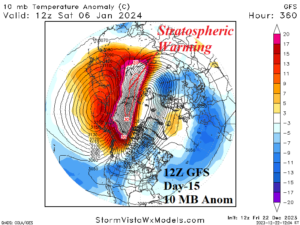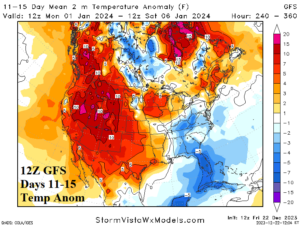Graph Cast AI Identifies High Wind Events for Western Europe
12/20/2023, 12:38 pm ESTActive Madden Julian Oscillation Combined with Warming Stratosphere Creates Low Risk “Polar Vortex” Threat January 4th
12/26/2023, 8:15 am EST

Fig. 1-2: Stratospheric warming is boldly indicated in 15 days across Northeast Asia and the attendant cold air generation at ground level in the 11-15-day period across Russia.
Discussion: Natural gas markets are concerned regarding the mid-winter El Nino analogs which end the early winter warmth and introduce colder/snowy weather for January increasing heating demand. An added concern is the emergence in the past 2 days of stratospheric warming forecasts in 12-16 days across North/Northeast Asia to the polar region (Fig. 1). Arctic air is generated by stratospheric warming events as observed earlier this month across Russia. A second arctic air mass is ahead forming beneath the stratospheric warming over Russia in early January (Fig. 2). The first arctic air mass earlier this month was ejected into China. Will this one travel cross polar and into North America? Close monitoring ahead is warranted!
The 12Z GFS indicates a piece of an arctic air mass moves into the Northeast U.S. in the Jan. 3-5, 2024, timeframe. The 12Z GFS remains warm in the 6-10-day period (Fig. 3) but trends colder East in the 11-15-day period (Fig. 4) as late in that time a much colder change is projected for the Northeast.


Fig. 3-4: The 12Z GFS medium-range temperature anomaly forecast.
| Dates | HDD Forecast | 12-Hr Change | 24-Hr Change | 30-Year NML | 10-Year NML |
| Dec. 22-28
| 139.6 | 0.0 | +2.1 | 200.5 | 193.4 |
| Dec. 29-Jan. 4
| 172.3 | -12.5 | -33.2 | 205.6 | 200.7 |
| Jan. 5-11
| 213.5 | +6.7 | +4.3 | 209.4 | 205.3 |
Table 1: The 12Z GFS U.S. gas population weight HDD forecast compared to 12 and 24 hours ago.
